
views
X
Research source
While the finer points of fouls and pool dimensions are somewhat complex, the basics of the game are easy to learn and start playing quickly.
Understanding the Basic Rules
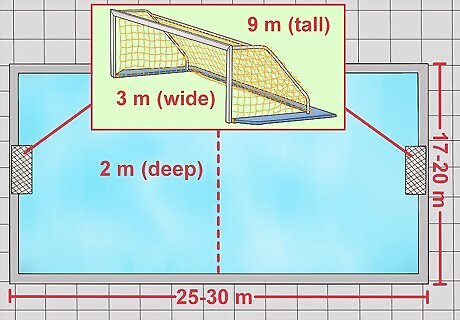
Play in a rectangular pool with two goals on opposite ends. The object of water polo is identical to soccer -- put the ball into the opposing team's goals to score, and the team with more goals wins. In regulation games, a goal is .9 meters (3 ft) tall and 3 meters wide, but you can use whatever you have around to make a good net. No player should be able to touch the bottom of the pool. Don't have goals and want to play a casual game? You can turn over trashcans instead and play without a goalie. Regulation pools are 25–30 meters (82–98 ft) long and 17-20 meters wide. They should be about 2 meters (7 ft) deep.
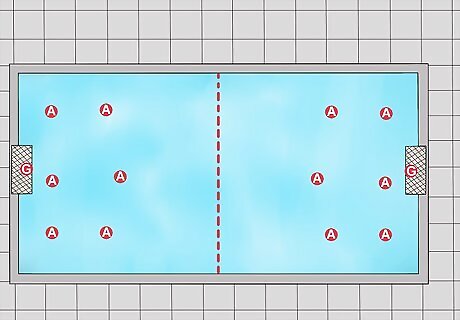
Divide into two even teams, each with one goalkeeper. In regulation games, teams each have seven players -- six attackers and one goalie. However, depending on your level of competition and the size of the pool, the most important thing is to have an even number of players on each team. In order to know who is on what team, players usually wear matching water polo caps. Goalies typically wear cap #1 and their caps will have a stripe through it to separate them from the field players. If you have more than 14 people playing it is a good idea to have substitutes. Water polo is very tiring. If you're just playing for fun and have an odd number of players, you can make one player "always offense." They simply play for the team that currently has the ball.
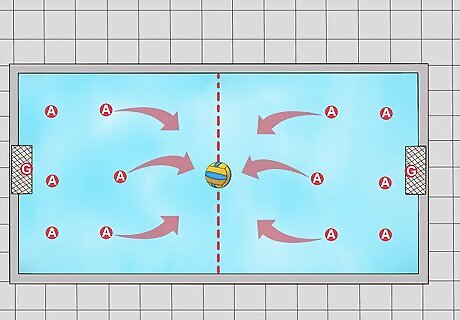
Start the game by racing to the ball in the center of the pool. The game starts with a swim-off, where the two teams swim to get the ball and start the attack. In regulation games a machine or referee drops the ball in the center, but you can just as easily leave a ball in the center of the pool and say "go!" The team that gets the ball first is on offense first.
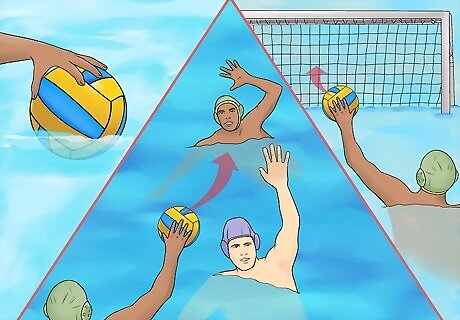
Hold, pass, and shoot the ball with only one hand at a time. Using both hands at the same time is a foul. The only exception to this is for the goalie, who can use both hands within a 5-meter area of the goal. If the keeper swims forward to join the attack, they too must only use one hand at a time. This rule is to prevent clutching or holding the ball for insanely long periods, making it impossible for the other team to win it back.
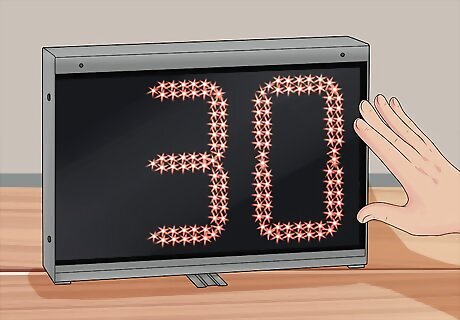
Set a 30 second shot clock, like in basketball, to score by. Because you can't foul people to get the ball, one team could theoretically score one goal then hold onto it for the rest of the game. This is why water polo has a 30-second shot clock that starts as soon as a team gets the ball. If a team does not score or reset the clock in 30 seconds, the defensive team gets the ball for a free throw where it currently sits. The shot clock only resets when: The defensive team gets clear control of the ball. The offense scores. There is a major foul.
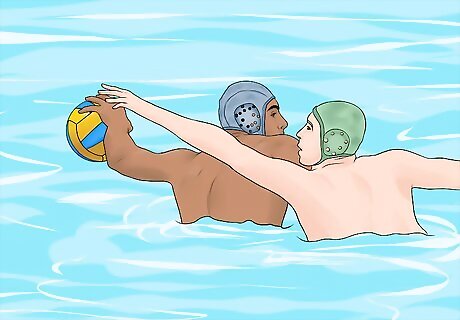
Wrestle for the ball, but not the player, to win possession without fouling. Water polo is an incredibly physical game, both above the water and below it, but almost all player-to-player contact is a foul. You can, however, go for the ball, knocking it out of a player's hands to regain possession. If you hit the ball out or the player uses two hands to protect it, the ball is yours. You cannot touch or impede players without the ball. You cannot hold the ball underwater to avoid getting it taken. You cannot grab, kick, or push a player while ignoring the ball.
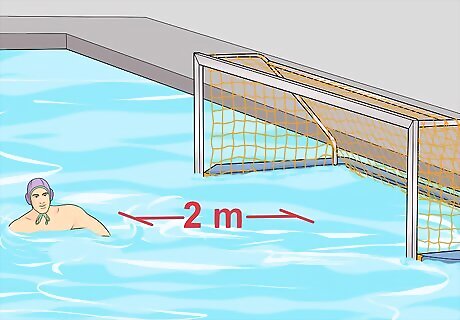
Do not go closer than 2 meters (6.6 ft) from the goal unless you have the ball. The 2-meter line is marked by red lines on the sides of professional pools, and offensive players cannot cross this line unless they are carrying the ball. You cannot receive a pass if you're already past this mark, either -- you must have the ball as you cross it, or you can't cross it at all. The goalie, of course, can be within the 2-meter line without the ball. For less serious games, remember that 2 meters (6.6 ft) is roughly the height of an average adult male. Stay this far from goal if playing a casual game.
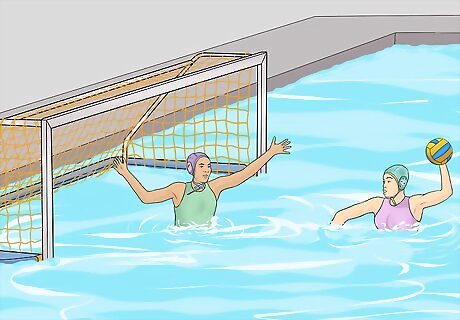
Restart missed shots with a throw from goal or a corner throw depending on who touched it last. This is similar to soccer, but with one catch -- a missed shot can deflect off a defender and still be the defense's ball. However, if a goalkeeper deflects a ball away from goal and over the end line, the offense gets a corner throw. Goal Throw: If the offense misses or deflects a shot off of a defender, not the goalie, the defensive teams gets a free throw anywhere behind the 2-meter line. Corner Throw: If the goalie deflects the ball out, or a defender intentionally throws the ball behind their own goal, the offense gets a free pass from the edge of the pool at the 2-meter line.
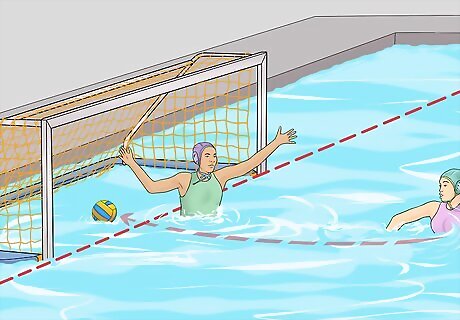
Score a goal when the entire ball passes completely over the goal line. This means that the whole ball passes by both posts. It does not need to hit the back of the net in order to score. In regulation games, this scoring line is marked by an all white goal line.
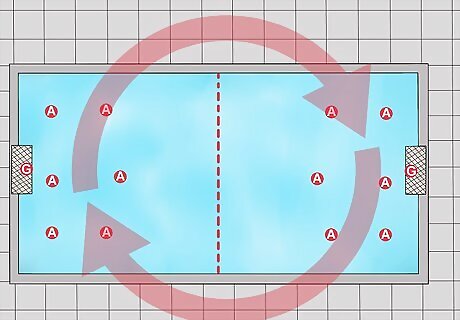
Restart play after a goal only once both teams are in their own half. Once a team scores, they must return to their half of the pool before the game can start again. The goalie who was scored on can then pass from their goal to a teammate, restarting the game. The shot clock starts once this first pass is made.
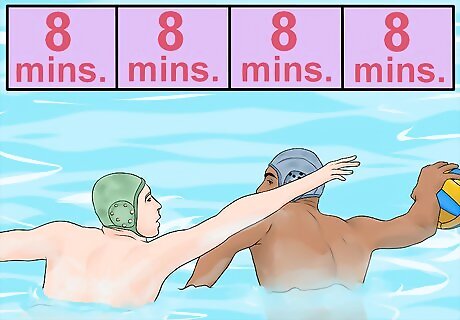
Play four separate 8-minute quarters, switching sides after the first two. This is the regulation length of a game, so you can adjust it to your liking if you're just playing for fun. In general, there are 2-minute breaks between each quarter, with 10 minutes for halftime between the second and third quarters. Younger age groups usually play 5-6 minute quarters. The clock stops after a major foul (exclusion) or a goal and only starts again when the ball is back in play.
Calling Fouls
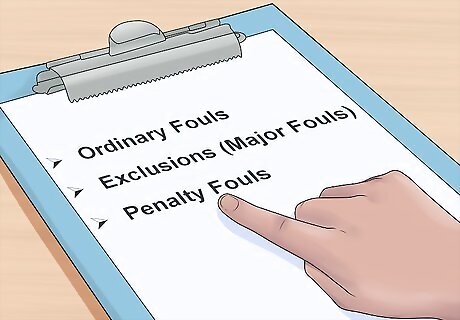
Understand the three categories of fouls and their consequences. Fouls in water polo are a mixture of basketball and hockey rules, and they range from minor fouls to "brutality" fouls that cause a permanent ejection from the game. Each foul is detailed, along with the referee's reaction and signal, below: Ordinary Fouls: Referee blows the whistle once and points in the direction the team is attacking towards. Restart is a free throw from the location of the foul. Two whistles indicate that the offense, not the defense, caused the foul. Exclusions (Major Fouls): Referee blows the whistle twice quickly, then one long blast. They spin their arms to indicate a player must leave, and the fouling player must swim to the edge of the pool for 20 seconds, and play starts with a free throw. Penalty Fouls: Referee blows the whistle three times, like above, then raises 5 fingers above his/her head. The fouler leaves the field and play starts with a free shot on the 5-meter line for the fouled team.
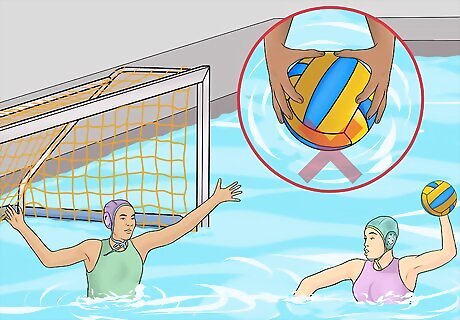
Restart ordinary fouls with a free throw at the spot of the foul. These are also called minor fouls. Ordinary fouls are not counted or used against players, and the clock does not stop after they are called. They are by far the most common fouls in water polo, and include: Touching the ball with two hands Touching the bottom of the pool Holding the ball underwater to prevent stealing Impeding, or getting in the way of players who don't have the ball to prevent them from moving. Letting the shot clock expire Throwing a ball outside of the pool.
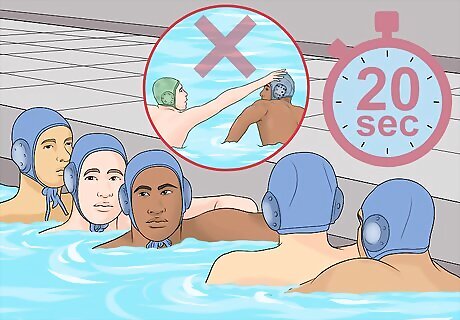
Sit players for 20 seconds, with their team playing a man down, for exclusion fouls. These are also called major fouls and are for more serious and aggressive conduct. Once called, the fouling player must immediately swim to a designated zone in front of their bench, usually the halfway line. After 20 seconds or a goal is scored, whichever is first, they can swim back in and resume play. Exclusions fouls are for: Pulling, holding, or sinking players without the ball. Splashing water in a player's face Blocking a shot with two arms Kicking or hitting another player violently. Disrespecting the game or referee (swearing, leaving the pool and getting back in, spitting)
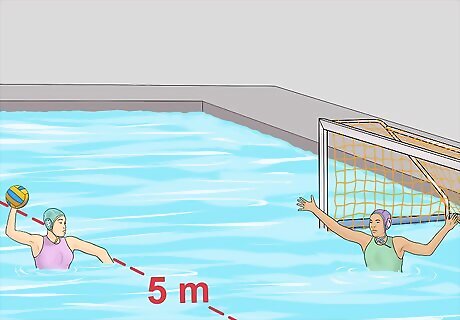
Grant penalty shots for fouls within the offensive 5-meter line or very rough fouls. The foul must be within the 5-meter line, as well as preventing a "probable goal." Any foul, if it takes away a probable goal, can be a penalty foul. Your team gets the ball at the 5-meter line against the goalie, and play resumes after the shot. Very violent fouls, called "brutality," can result in a penalty shot regardless of where in the pool the foul was committed. Most penalty fouls are called when a defender fouls a shooting player from behind. The goalie must be completely within the goal for the shot, not in front of it.
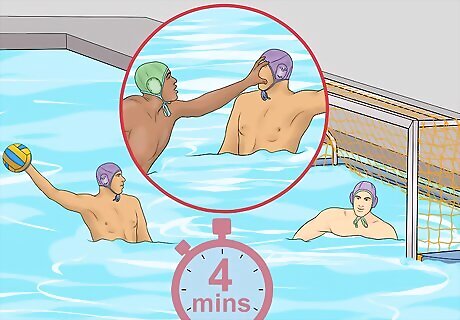
Play a player down for four minutes if charged with a brutality. These are for excessive or violent fouls, like kicking, striking, or extreme language or unsportsmanlike conduct. You must leave for the remainder of the game, and your team will play a man down for four minutes. If a penalty foul is called for a brutality, the team who was fouled gets the ball back at the half line after shooting, even if they scored. A strike that is determined as deliberate is the most common brutality called.
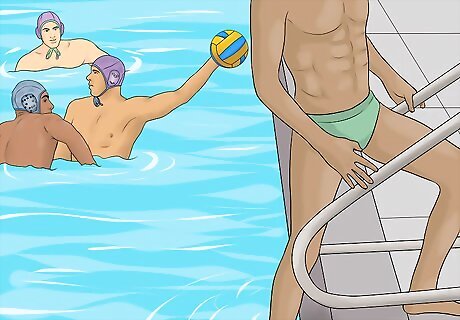
Leave the game if you're called for three major fouls. If you receive three exclusion calls against you, you are out for the remainder of the game. Unless the final foul was considered a brutality, your team may substitute another player in your place when you leave. Your team still has to play with the 20-second exclusion -- you can substitute after this period is over.
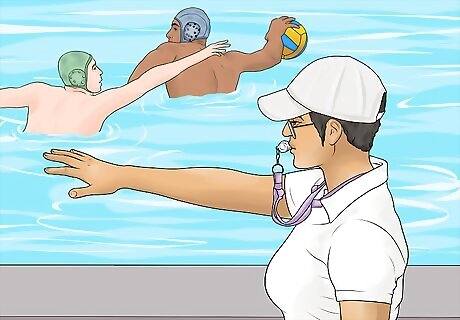
Understand that a ref can call "advantage" if it is better to keep playing than take a foul. Again, this is similar to soccer. If the referee thinks you're better off keeping the ball, such as being fouled right after you make a good pass, they can say "advantage" to acknowledge the foul but keep your team's offensive momentum. In general, overly violent or dangerous fouls are called immediately even if there is an advantage.
Understanding Basic Strategies
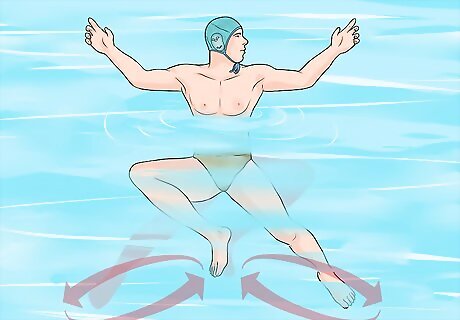
Use the "eggbeater" kick to stay afloat while conserving energy. Regulation water polo players are not allowed to push off of the wall or sides of the pool. You must tread water the entire time. This is incredibly exhausting, but good players use a rounded, more efficient motion to stay afloat: Bend your knees roughly 90-degrees as if you were sitting. Keep your legs slightly wider than shoulder width apart. Rotate your right leg counterclockwise. Rotate your left leg clockwise. Time your legs so that they alternate fluidly.
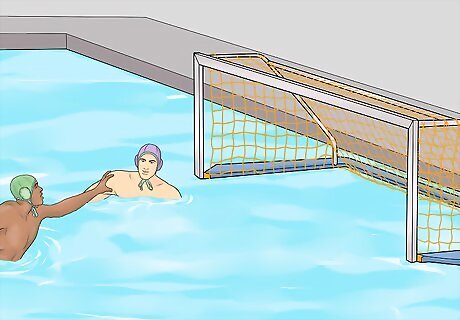
Hold one player up in front of the goal to direct your attack. They are called the center forward, and sit about 2 meters (7 ft) outside of the goal to cause confusion and take close-range shots. When you get the ball as a center your goal is to quickly turn and fire a shot off. Centers take the bulk of physical play, and must have the best endurance and strength. Centers are also called "Hole Sets" by some coaches.
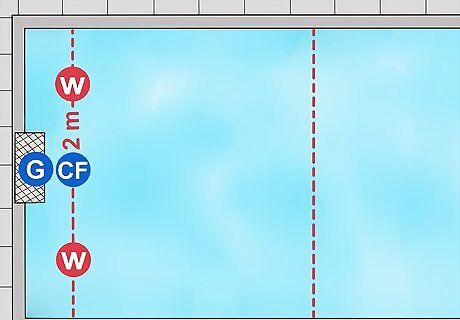
Place two players at the 2-meter line, on either side of the goal, as Wings. You should have a line of three players in front of the goal on offense -- two wings on the sides and one center forward in the middle. A wing's goal is to take long range shots, as well as pass back and forth with the center to make space for a shot. Wings need to have quick, accurate, and long-range shots. Remember that you cannot use the walls to push off. You should be a few meters in from the wall as a wing.
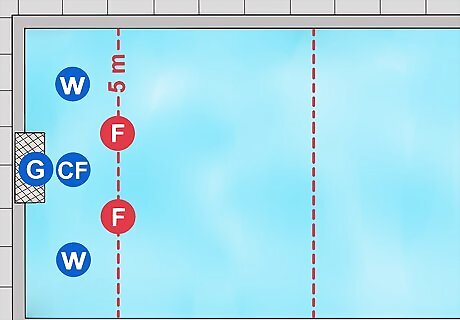
Place your two "Flats" on the 5-meter line, between the wings and center. Flats are great passers and long-range shooter. They swim at the goal to draw defenders, which hopefully opens up space for the center forward to get free. They must race back on defense when the ball is turned offer. Flats tend to be very quick, very mobile swimmers.
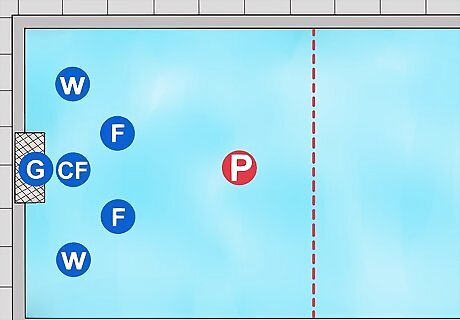
Keep one player behind everyone, near the half line and in the center of the pool. This is your "Point" player. They are the first ones back on defense, and the main passers of the team, seeing and setting the entire offense. They rarely shoot, instead looking for the best, most dangerous passes.
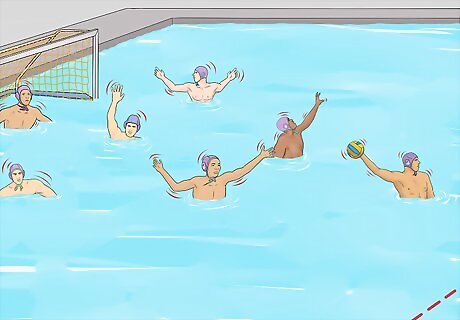
Keep your wings, point, and flats moving to confuse the defense. The movement of your perimeter players (everyone but the center forward) is what opens up shots and breaks down good defenses. This can include swapping positions, crashing towards the goal, or rotating around the pool. The center forward can move, but they are generally needed to keep the essential space in front of the goal open in case of deflected shots or sudden shooting opportunities.
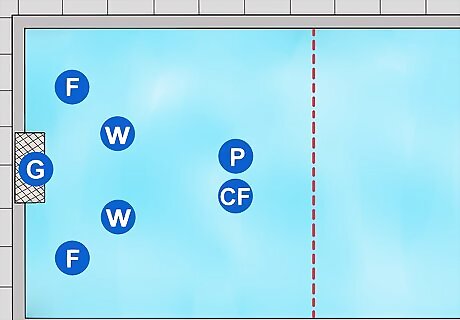
Flip the offensive formation on defense. You simply slide your formation down the pool on defense. The point guards the opposing center forward, and the center forward guards the point. Your wings will cover their flats and your flats cover their wings. In general, you will play either man to man or zone defense: Man to Man Defense: Each player follows their match around the pool, no matter where they go. Zone Defense: Each player stays in their position, trading defensive marks as the other team changes positions. If the opposing team has a very good center forward, this position is sometimes double-teamed, leaving the offenses point player alone.

















Comments
0 comment